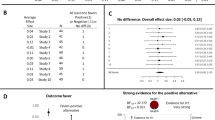Abstract
Five-year-old children received training on four symbolic match-to-sample tasks with single-element stimuli (A1-B1, A2-B2; P1-Q1, P2-Q2). Then they received training on four novel matching tasks with AB compounds as samples and X stimuli as comparisons. The children received positive feedback for selecting X1 when given compounds representing sample-correct comparison relations (A1B1-X1, A2B2-X1) and for selecting X2 when given sample-incorrect comparison relations (A1B2-X2, A2B1-X2). Finally transfer from AB-X to PO-X was assessed (P1Q1-X1, P2Q2-X1, P1Q2-X2, P2Q1-X2). Most children did not learn the AB-X tasks unless they were first trained to respond to all compound elements, and they did not reliably show transfer unless they had first learned that the compounds (e.g., A1B1) represented sample-comparison relations (A -B1).
Similar content being viewed by others
References
ASTLEY, S. L., & Wasserman, E. A. (1999). Superordinate category formation in pigeons: Association with a common delay or probability of food reinforcement makes perceptually dissimilar stimuli functionally equivalent. Journal of Experimental Psychology: Animal Behavior Processes, 25, 415–432.
BARNES, D., HEGARTY, N., & SMEETS, P. M. (1997). Relating equivalence relations to equivalence relations: A relational framing model of complex human functioning. The Analysis of Verbal Behavior, 14, 57–83.
BARNES-HOLMES, D., & BARNES-HOLMES, Y (2000). Explaining complex behavior: Two perspectives on the concept of generalized operant classes. The Psychological Record, 50, 251–265.
CARPENTIER, F., SMEETS, P. M., & BARNES-HOLMES, D. (2000). Matching compound samples with unitary comparisons: Derived stimulus relations in adults and children. The Psychological Record, 50, 671–685.
CARTER, D. E., & WERNER, T. J. (1978). Complex learning and information processing in pigeons: A critical analysis. Journal of the Experimental Analysis of Behavior, 29, 565–601.
CUMMING, W. W., & BERRYMAN, R. (1965). The complex discriminated operant: Studies of matching-to-sample and related problems. In D. J. MOSTOFSKY (Ed.), Stimulus generalization (pp. 284–330). Stanford, Ca: Stanford University Press.
DOUGHER, M. J., & MARKHAM,, M. R. (1994). Stimulus equivalence, functional equivalence, and the transfer of function. In S. C. Hayes, L. J. Hayes, M. Sato, & K. ONO (Eds.), Behavior analysis of language and cognition (pp. 71–90). Reno, Nv: Context Press.
HUGUENIN, N. H. (2000). Reducing overselective attention to compound visual cues with extended training in adolescents with severe mental retardation. Research in Developmental Disabilities, 21, 93–113.
MACKINTOSH, N. J. (1975). A theory of attention: Variations in the associability of stimuli with reinforcement. Psychological Review, 82, 276–298.
MARKHAM, M. R., & DOUGHER, M. J. (1993). Compound stimuli in emergent stimulus relations: Extending the scope of stimulus equivalence. Journal of the Experimental Analysis of Behavior, 60, 529–542.
PÉREZ-GONZÁLEZ, L. A. (1994). Transfer of relational stimulus control in conditional discriminations. Journal of the Experimental Analysis of Behavior, 61, 487–503.
PEREZ-GONZÁLEZ, L. A., & SERNA, R. W. (1993). Basic stimulus control functions in the five-term contingency. Experimental Analysis of Human Behavior Bulletin, 11, 52–54.
PETERSON, G. B. (1984). How expectancies guide behavior. In H. L. Roitblat, T G. BEVER, & H. S. TERRACE (Eds.), Animal cognition (pp. 135–148). Hillsdale, Nj: Erlbaum.
SAUNDERS, K. J., WILLIAMS, D. C, & SPRADLIN, J. E. (1996). Derived stimulus control: Are there differences among procedures and processes? In T. R. Zentall & P. M. SMEETS (Eds.), Stimulus class formation in humans and animals (pp. 93–109). Amsterdam: Elsevier.
SERNA, R. W. (1991). Interchangeability of stimulus terms in five-term contingencies. Experimental Analysis of Human Behavior Bulletin, 9, 2–3.
SIDMAN, M. (1994). Equivalence relations and behavior: A research story. Boston, Ma: Authors Cooperative, Inc.
SINGH, N. N., & SOLMAN, R.T (1990). A stimulus control analysis of the picture-word problem in children who are mentally retarded: The blocking effect. Journal of Applied Behavior Analysis, 23, 525–532.
SMEETS, P. M., BARNES, D., & ROCHE, B. (1997). Functional equivalence in children: Derived stimulus-response and stimulus-stimulus relations. Journal of Experimental Child Psychology, 66, 1–17.
SMEETS, P. M., BARNES, D., SCHENK, J. J., & DARCHEVILLE, J. C. (1996). Emergent simple discriminations and conditional relations in children, intellectually impaired adults, and normal adults. The Quarterly Journal of Experimental Psychology, 49B, 201–219.
SMEETS, P. M., BARNES-HOLMES, D, & ROCHE, B. (2001). Derived stimulus-response and stimulus-stimulus relations in children and adults: Assessing training order effects. Journal of Experimental Child Psychology, 78, 130–154.
SMEETS, P. M., & STRIEFEL, S. (1994). A revised blocked-trial procedure for establishing arbitrary matching in children. The Quarterly Journal of Experimental Psychology, 47, 241–261.
SPRADLIN, J. E., COTTER, V. W., & BAXLEY, N. (1973). Establishing a conditional discrimination without direct training: A study of transfer with retarded adolescents. American Journal of Mental Deficiency, 77, 556–566.
STROMER, R., MCILVANE, W. J., DUBE, W. J., & MACKAY, H. A. (1993). Assessing control by elements of complex stimuli in delayed matching to sample. Journal of the Experimental Analysis of Behavior, 59, 83–102.
STROMER, R., MCILVANE, W. J., & SERNA, R. W. (1993). Complex stimulus control and equivalence. The Psychological Record, 43, 585–598.
STROMER, R., & STROMER, J. B. (1990). The formation of arbitrary stimulus classes in matching to complex stimuli. The Psychological Record, 40, 51–66.
URCUIOLI, P. J., & ZENTALL, T.R. (1993). A test of comparison-stimulus substitutability following one-to-many matching by pigeons. The Psychological Record, 43, 745–759.
WASSERMAN, E. A., & DEVOLDER, C. L. (1993). Similarity-and nonsimilarity-based conceptualization in children and pigeons. The Psychological Record, 43, 779–793.
WASSERMAN, E. A., DEVOLDER, C. L, & COPPAGE, D. J. (1992). Nonsimilarity-based conceptualization in pigeons via secondary or mediated generalization. Psychological Science, 3, 374–378.
WETHERBY, B., KARLAN, G. R., & SPRADLIN, J. E. (1983). The development of derived stimulus relations through training in arbitrary-matching sequences. Journal of the Experimental Analysis of Behavior, 40, 69–78.
Author information
Authors and Affiliations
Corresponding author
Rights and permissions
About this article
Cite this article
Carpentier, F., Smeets, P.M. & Barnes-Holmes, D. Establishing Transfer of Compound Control in Children: A Stimulus Control Analysis. Psychol Rec 52, 139–158 (2002). https://doi.org/10.1007/BF03395420
Published:
Issue Date:
DOI: https://doi.org/10.1007/BF03395420




